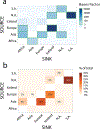Global dissemination of influenza A virus is driven by wild bird migration through arctic and subarctic zones
- PMID: 36239465
- PMCID: PMC9797457
- DOI: 10.1111/mec.16738
Global dissemination of influenza A virus is driven by wild bird migration through arctic and subarctic zones
Abstract
Influenza A viruses (IAV) circulate endemically among many wild aquatic bird populations that seasonally migrate between wintering grounds in southern latitudes to breeding ranges along the perimeter of the circumpolar arctic. Arctic and subarctic zones are hypothesized to serve as ecologic drivers of the intercontinental movement and reassortment of IAVs due to high densities of disparate populations of long distance migratory and native bird species present during breeding seasons. Iceland is a staging ground that connects the East Atlantic and North Atlantic American flyways, providing a unique study system for characterizing viral flow between eastern and western hemispheres. Using Bayesian phylodynamic analyses, we sought to evaluate the viral connectivity of Iceland to proximal regions and how inter-species transmission and reassortment dynamics in this region influence the geographic spread of low and highly pathogenic IAVs. Findings demonstrate that IAV movement in the arctic and subarctic reflects wild bird migration around the perimeter of the circumpolar north, favouring short-distance flights between proximal regions rather than long distance flights over the polar interior. Iceland connects virus movement between mainland Europe and North America, consistent with the westward migration of wild birds from mainland Europe to Northeastern Canada and Greenland. Though virus diffusion rates were similar among avian taxonomic groups in Iceland, gulls play an outsized role as sinks of IAVs from other avian hosts prior to onward migration. These data identify patterns of virus movement in northern latitudes and inform future surveillance strategies related to seasonal and emergent IAVs with potential public health concern.
Keywords: Iceland; influenza A virus; phylodynamics; subarctic; transmission; wild birds.
© 2022 John Wiley & Sons Ltd.
Figures





References
-
- Arctic Monitoring and Assessment Programme (AMAP). (2019). AMAP Climate Change Update 2019: An Update to Key Findings of Snow, Water, Ice and Permafrost in the Arctic. Retrieved from Oslo, Norway:
-
- Baele G, Ayres DL, Rambaut A, Suchard MA, & Lemey P (2019). High-Performance Computing in Bayesian Phylogenetics and Phylodynamics Using BEAGLE. In Anisimova M (Ed.), Evolutionary Genomics: Statistical and Computational Methods (pp. 691–722). New York, NY: Springer New York. - PubMed
Publication types
MeSH terms
Grants and funding
LinkOut - more resources
Full Text Sources
Medical

